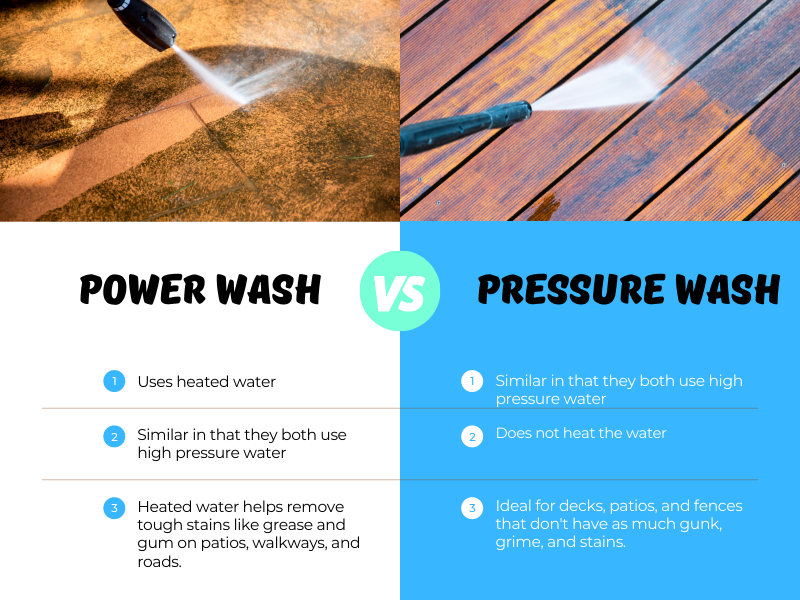Exactly How Pressure Washing Lockhart Recovers Surfaces Without Causing Any Kind Of Damages
Exactly How Pressure Washing Lockhart Recovers Surfaces Without Causing Any Kind Of Damages
Blog Article
Stress Washing 101: Tips and Techniques for a Pristine Exterior
Pressure cleaning serves as an invaluable tool in keeping the visual allure of numerous outside surface areas, successfully getting rid of built-up dirt and discolorations. As we check out these crucial aspects, you'll discover exactly how to elevate your stress cleaning abilities and ensure your home stays in immaculate condition.
Recognizing Stress Laundering
Recognizing pressure washing is important for achieving optimal lead to exterior cleaning jobs. This technique employs high-pressure water spray to eliminate dirt, crud, mold, and other impurities from different surface areas, substantially improving the aesthetic charm and durability of landscapes and structures.
The procedure involves using specific tools that produces water pressure generally ranging from 1,500 to 4,000 psi, relying on the surface area and cleaning needs. Softer surfaces like wood may demand reduced pressure settings to avoid damage, while concrete can endure higher pressures for reliable cleaning. Along with stress, the temperature level of the water can also play a critical duty; warm water can dissolve grease and oil better than cold water.
Choosing the suitable nozzle is an additional essential facet, as various nozzles create differing spray patterns and stress degrees. Comprehending the types of surfaces-- such as vinyl, asphalt, or brick-- helps in tailoring the stress cleaning strategy to stay clear of prospective damage.

Essential Devices Needed
To kick off an effective stress cleaning job, having the right tools on hand is important. Select one with flexible pressure setups, generally varying from 1,500 to 3,000 PSI, depending on the surface areas you'll be cleansing.
Next, purchase different nozzles to achieve different spray patterns - Pressure Washing Lockhart. A 0-degree nozzle provides a focused stream for tough spots, while a 40-degree or 25-degree nozzle is perfect for wider applications

Safety And Security Safety Measures to Follow
Focusing on security is important when involving in pressure washing, as the high-pressure water jets can position significant threats if not taken care of correctly. Before starting, evaluate your workspace for prospective risks such as electric lines, vulnerable structures, or unsafe surface areas. Make sure that the area is free from individuals, animals, and blockages to avoid accidents.
Constantly use proper individual safety equipment (PPE) This includes safety and security goggles to secure your eyes from flying particles, gloves to shield your hands, and durable shoes with non-slip soles. Take into consideration wearing lengthy sleeves and pants to minimize skin direct exposure to high-pressure water, which can trigger injuries.
Maintain a risk-free distance from the surface area being cleaned up, as the pressure can create damages or injury if aimed directly at skin or fragile products. Acquaint on your own with the pressure washer's controls and adjust the pressure setups according useful content to the details task at hand. Never run the stress washer while on a ladder or raised surface area without appropriate stablizing, as this boosts the risk of falls. By adhering to these safety and security precautions, you can make sure a more secure and much more reliable pressure cleaning experience.
Methods for Efficient Cleaning
Having actually developed a strong foundation of safety preventative measures, it's time to concentrate on the techniques that will make sure reliable cleaning with a pressure washer. The very first step is to pick the appropriate nozzle. A bigger spray pattern, such as a 25-degree nozzle, is ideal for surface areas like driveways, while a 40-degree nozzle matches fragile locations like repainted timber.
Following, constantly begin cleaning up from the leading and work your way down. This technique stops dust and particles from dropping onto areas that have currently been cleansed. Preserve a constant distance of roughly 12 to 24 inches from the surface to prevent damage.

Finally, keep in mind to rinse the surface after cleansing to eliminate any kind of recurring cleansing representatives. This last action is important for protecting against streaks and guaranteeing an immaculate coating. By carrying out these methods, you will accomplish optimum results and prolong the life of your surfaces, boosting the general appearance of your home.
Preserving Your Stress Washing Machine
How can you guarantee the longevity and optimal efficiency of your stress washer? Furthermore, clean the air and examine filter to advertise optimum air movement and efficiency.
After each usage, it is necessary to purge the system with clean water to get rid of cleaning agents and debris that can trigger clogging. Store your pressure washer in a dry, sheltered setting to protect it from weather condition elements, and make sure that all connections are secure before storage.
Pay special focus to the nozzle; clean it often to stop blockages and keep reliable splashing. In addition, keep the high-pressure tube complimentary from kinks and slits, as any kind of damages can endanger capability and safety.
Finally, describe the maker's guidebook for certain upkeep referrals, including seasonal checks. By sticking to these methods, you can extend the life of your pressure washer and guarantee it operates at peak performance whenever you need it.
Conclusion
In verdict, stress washing serves as a reliable method for renewing exterior surfaces, effectively removing accumulated dust and discolorations. Normal maintenance of stress washing tools, including routine oil modifications and nozzle cleaning, is essential to ensure constant efficiency.

Report this page